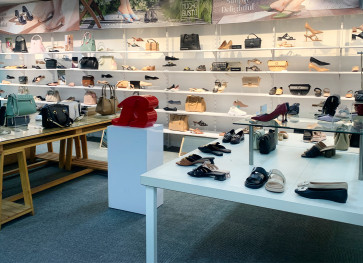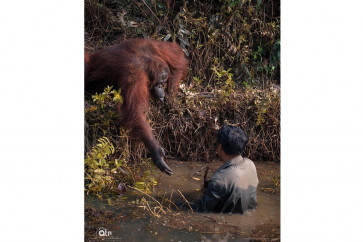Spring time in Jeju-do, Korea's little Hawaii
A panoramic view of the Jeju landscape from a cliff overlooking the Pacific Ocean at one of the premier resorts, Jungmun resort complex, on the island’s south coast
Change Size

A panoramic view of the Jeju landscape from a cliff overlooking the Pacific Ocean at one of the premier resorts, Jungmun resort complex, on the island’s south coast. (JP/Damar Harsanto)
The TV weather forecast and a native Jeju resident on board my plane heading to Jeju island, Korea's largest resort island, hinted that I might not find springtime at its best in "Little Hawaii", located 130 kilometers south of the Korean peninsula.
"Cloudy days are expected this weekend," the forecast said.
"Jeju's weather is different from other parts of Korea. It rains a lot," added the Jeju native woman sitting beside me on the plane, deflating my anticipation of seeing flowers blooming and trees at their greenest.
The sky was clear but the sun was not at its brightest, although the crisp winds blowing sent a good omen as my plane touched down at Jeju International Airport.
"You are so lucky as we have a clear day today," the tour guide, who prefers to be called Kim, told the group of journalists who had arrived to spend the weekend on the island.
Just like the many other Koreans who bear the names Kim, Park or Lee, she proudly told us so many Koreans have those names that there is a joke that if someone were to throw a stone from the top of Nam San, the tallest hill in Seoul, it would hit either a Kim, a Park or a Lee.
During our trip to the hotel, Kim added that if we were lucky we would see the rare sight of local women divers. And indeed we were lucky, as we happened to spot five local women in tight black outfits heading to the shore. We stopped the bus and approached them.
"Annyong haseyo," I said, surprising them with the Korean greeting. But they certainly amazed me even more, these modest women in their 60s going diving without air tanks or standard snorkels, just baskets dangling on their backs.
"We look for seaweed and shells," one of the divers said warmly in Korean.
They checked their equipment just like pro divers before readying themselves to leap into the calm and cold seawater.
"Please, be careful," I said in their language. They giggled at my awkward pronunciation of the Korean sounds, and a few seconds later plunged into the waters.
In the next minutes, I realized my warning was entirely unnecessary, for the sea had been their playground for at least the past three decades. Being old did not affect their moves; they were as agile and swift as synchronized swimmers going about their daily routines. Once in a while, they appeared at the surface to take a gulp of air and whistle, emitting a sound that reminded me of a dolphin.
According to Kim, whose aunt is also a traditional diver, the divers go out on their business at least 10 days every month throughout the year to help make a living while their husbands go out fishing in the open sea.
"Haenyo women (the local name for the divers) even go out during the winter," Kim said.
Their routines are tough, as they dive from 9 a.m. to 4 p.m., sometimes without taking a break for a drink or meal. At dawn, they take the items they have collected directly to the marine product dealers.
"They can earn up to US$60 a day," Kim said. "It is a decent living, but if we compare that to the high risk they face, then it is a tough job."
That's why, Kim said, the number of women divers is falling, with just the elderly carrying on the tradition. Very few young women on the island are willing to do the work, instead looking for less risky jobs at factories, available to them in part thanks to their higher level of education.
A survey by the Jeju provincial administration in 2006 found that of the total 5,406 active women divers, most are older than 60 (65.8 percent) or in their 50s (24.6 percent). Only a few -- 9.7 percent -- are in their 30s or younger. This is in contrast to another report that found that the percentage of divers in the 1970s who were older than 60 was only 4.6 percent, with many younger women involved in the trade.
My next stop was the island's famous and picturesque Cheonjiyeon waterfall, with its silvery cascades and snowy surroundings forming a perfect backdrop to its beauty.
To reach the site I had to cross a bridge over a small river alive with big and colorful fish. A giant statue stands at one end of the bridge -- Dolharubang, the Grandfather stone, which I later found was an icon across the island.
This statue, carved from the island's black porous basalt, has become the symbol of Jeju. It is a favorite for honeymooners who visit this area because local myths say a couple who touch the Grandfather's nose will be blessed with a son.
Passing the statue, I had to follow the 300-meter pathway leading to the waterfall, a path lined with subtropical trees. I could hear the sound of the waterfall in the distance.
Cheonjiyeon, or the gods' pond, is only 22 meters high, 12 meters wide and 20 meters deep. But what it lacks in size it makes up for in the pristine conditions around the pond that justify its legend-inspired name. According to legend, seven fairies who served the King of Heaven descended to the pond by a cloud stairway and bathed in its clear, clean waters. The legend is recreated every May at the annual Seven Fairies Festival.
After visiting the falls, we drove a few minutes to the Gwangmyeong temple for a tea ceremony, known as Dado.
I sat cross-legged on a mat with a set of cups, teapot and hot water thermos. Later I learned that the Dado -- which requires meticulous etiquette to warm the cups, to use a special bamboo spoon for the dried tea leaves and to add just the right amount of water -- is both exciting and calming, made all the more so by the traditional Korean music that accompanies it.
"The essence of the ceremony is to take time and enjoy the tea," the trainer explained, repeatedly reminding us to keep from making any noise but to enjoy the tea in silence.
I made four cups of tea, all of which tasted bitter and warm, but sampling an assortment of sweet and cold fruitcakes between servings made the experience perfect. I left the ceremony room with a clear mind and fresh tongue.
These were just some highlights: This little island (41 kilometers wide and 71 kilometers long), known by locals as Jeju-do, has too much to offer to be fit into a one or two-day tour.
Heading back to Jeju International Airport, I saw in the distant haze Mount Halla, whose crater lake, Baekrok-dam, beckons from its summit.
I will save that for my next visit, I promised myself and the mountain. Someday.
The Jeju tour is part of the three-week SNU-LG Sangnam Press Fellowship program.









